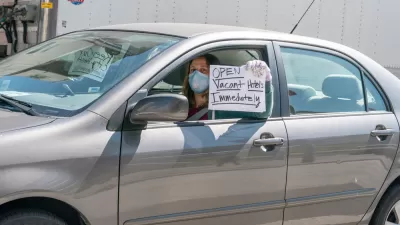As some governors open nonessential businesses, subjecting workers and customers to potential viral infection, others move beyond social distancing to the next steps, boxing in the coronavirus with testing, contact tracing, isolation, and quarantine.

Georgia, Oklahoma, South Carolina, and Alaska opened some nonessential businesses, like tattoo parlors, this past weekend, and more states, like Colorado, are set to relax restrictions next week, yet none have met the "downward trajectory of covid-like syndromic cases reported within a 14-day period" established by the White House "reopening" guidelines. While more diagnostic testing is needed, testing alone won't be sufficient to move to the next phases of the guidelines, particularly in light of the high percentage of asymptomatic people infected with the coronavirus.
"One of the things that's clear is that this is a highly infectious virus, and that many people don't show symptoms," states Dr. Tom Frieden, a former director of the Centers for Disease Control and Prevention who is now CEO of an initiative called Resolve to Save Lives during a 6-minute interview with John Yang of the PBS NewsHour on April 22.
That makes it even harder to control, but still possible. There's a lot we can do to be safer. And the more we do now, the sooner and more safely we can come out [from states' stay-at-home orders]. That means boxing it in, doing the testing, isolation, contact tracing, and quarantine, that box, to get the virus in smaller and smaller clusters and cases, so that we can come out more safely.
Frieden, who was also the New York City Health Commissioner under Mayor Michael Bloomberg, describes contact tracing and the other two public health strategies that accompany it: isolating the people who test positive and quarantining their contacts once found by the tracers, that are necessary to "get ahead of the curve" as opposed to flattening it with reactive mitigation strategies such as shelter-in-place and social distancing.
Contact tracing is a tried-and-true method of public health...It's old-fashioned public health, but it works. It's hard work, but it's how we can return to a new normal as soon and safely as possible.
Washington Post reporters Lena H. Sun, William Wan, and Yasmeen Abutaleb describe the importance of these containment strategies in the context of the Trump administration lacking an implementation plan in a far more comprehensive piece (source article) published April 10. The federal reopening guidelines were issued six days later.
Instead [of a national plan], a collection of governors, former government officials, disease specialists and nonprofits are pursuing a strategy that relies on the three pillars of disease control:
- Ramp up testing to identify people who are infected.
- Find everyone they interact with by deploying contact tracing on a scale America has never attempted before.
- And focus restrictions more narrowly on the infected and their contacts so the rest of society doesn’t have to stay in permanent lockdown [i.e., under stay-at-home orders.]
In recent days, dozens of leading voices have coalesced around the test-trace-quarantine framework, including former FDA commissioners for the Trump and George W. Bush administrations [Scott Gottlieb and Mark McClellan, respectively; see their American Enterprise Institute report.], Microsoft founder Bill Gates and top experts at Johns Hopkins, Columbia and Harvard universities.
In South Korea, Taiwan, China and Singapore, variations on this basic strategy were implemented by their national governments, allowing them to keep the virus in check even as they reopened parts of their economy and society.
According to a report [pdf] released April 10 by the Johns Hopkins Center for Health Security and the Association of State and Territorial Health Officials—which represents state health departments, "a case-based intervention approach (employed routinely for diseases like TB, measles, sexually transmitted infections, and Ebola) will be impossible to achieve for COVID-19 without a new national initiative that combines a massive expansion of rapid diagnostic tests in every community with an unprecedented growth in a public health workforce and adoption of new technologies dedicated to case identification and contact tracing in each state."
National approach?
Like so many aspects of the nation's response to the pandemic, contact tracing will be implemented not by federal leadership but the individual response of states, and in some cases that might involve a regional response.
In an April 10 interview with NPR (4-minute listen), the Centers for Disease Control and Prevention Director Robert Redfield tells science correspondent Rob Stein that for mitigation measures to ease up, "his agency is ramping up America's capacity to do more contact tracing."
An "army of health workers," he tells NPR, "along with ample testing, is what will be needed 'to make sure that when we open up, we open up for good.'"
"We have over 600 people in the field right now from CDC in all the states trying to help with this response, but we are going to have to substantially amplify that," he said.
"A plan is coming soon" to add more contact tracers, but the role of CDC will be to assist state workers in their contact tracing efforts; i.e., like testing, contact tracing will be a state responsibility. According to Frieden, 300,000 contact tracers will be needed.
However, the aforementioned states are not waiting to hire and train that army, nor ramp up diagnostic testing, as they take incremental steps to open their economies.
Technology
Redfield left the door open for contact tracing in the U.S. to employ cellphone data. "People are looking at all the different modern technology that could be brought to bear to make contact tracing more efficient and effective," he said. "Are there more tech-savvy ways to be more comprehensive in contact tracing? Currently these things are under aggressive evaluation."
Redfield returned to NPR on April 21 for a six-minute update on his agency's plans to assist states in their contact tracing efforts in the form of "community protection teams."
"Our nation is going to have to have a substantially enhanced public health workforce so that, during what I call the second wave of the coronavirus infection, we have the public health resources to stay in the containment mode," he said. "That's the key. We got to stay in containment mode."
State efforts
Selena Simmons-Duffin, a health policy reporter for NPR, describes the wide variation in what some of the states have planned.
Michigan says it has already trained 2,200 volunteers to do contact tracing ... Other big efforts include Massachusetts and Maryland, which are both planning to add 1,000 workers. But other efforts are on a much smaller scale. Mississippi told us they were looking to add 20 additional staff to help with contact tracing. Utah said it has reassigned 30 workers from its Medicaid program to help.
CARES Act funding
Two days later, the Department of Health and Human Services announced that $631 million from the Coronavirus Aid, Relief, and Economic Security (CARES) Act of 2020 would be awarded to state and local jurisdictions "to battle COVID-19 and expand their capacity for testing, contact tracing, and containment,” according to Secretary Alex Azar. However, that amount is "a fraction of what many officials say they need to safely restart their economies," reports Wan for the Post.
“It’s so hard to get people and leaders to think about public health. That’s how we have found ourselves in the situation we are now in, with so little capacity,” said Michael Fraser, chief executive of the Association of State and Territorial Health Officials.
The Hill reports that New York will partner with New Jersey and Connecticut to launch a "massive" tri-state effort, with a $10.5 million contribution from Michael Bloomberg through the Bloomberg School of Public Health at Johns Hopkins.
Gov. Gavin Newsom (D-Calif.) will hire and train up to 10,000 contact tracers, according to The Hill.
Success story
The Washington Post reporters described how "shoe-leather" contact tracing was key to eradicating Ebola, also a contagious virus but far deadlier than COVID-19, in Liberia in 2014.
Tolbert Nyenswah, who led the effort and now lives in the United States and teaches at Johns Hopkins, "has watched the disjointed U.S. response [to COVID-19] on TV with growing alarm."
“You cannot have leaders contradicting each other every day. You cannot have states waiting on the federal government to act, and government telling the states to figure it out on their own,” he said. “You need a plan.”
Additional reading:
-
What Is Contact Tracing? Here's How It Could Be Used to Help Fight Coronavirus, Time, April 22, 2020
Related in Planetizen:
-
President Trump's Plan to Reopen the Economy Rests with States, April 20, 2020
- BLOG POST: How City Planning Can Affect How Diseases Spread: "There are many ways that city planning and urban design can mitigate, or exacerbate, the spread of public health risks," by Kayla Matthews, June 10, 2018
- Going Viral, but Not in a Good Way [a planner's perspective on Ebola outbreak], October 20, 2014
FULL STORY: A plan to defeat coronavirus finally emerges, but it’s not from the White House

Maui's Vacation Rental Debate Turns Ugly
Verbal attacks, misinformation campaigns and fistfights plague a high-stakes debate to convert thousands of vacation rentals into long-term housing.

Planetizen Federal Action Tracker
A weekly monitor of how Trump’s orders and actions are impacting planners and planning in America.

San Francisco Suspends Traffic Calming Amidst Record Deaths
Citing “a challenging fiscal landscape,” the city will cease the program on the heels of 42 traffic deaths, including 24 pedestrians.

Defunct Pittsburgh Power Plant to Become Residential Tower
A decommissioned steam heat plant will be redeveloped into almost 100 affordable housing units.

Trump Prompts Restructuring of Transportation Research Board in “Unprecedented Overreach”
The TRB has eliminated more than half of its committees including those focused on climate, equity, and cities.

Amtrak Rolls Out New Orleans to Alabama “Mardi Gras” Train
The new service will operate morning and evening departures between Mobile and New Orleans.
Urban Design for Planners 1: Software Tools
This six-course series explores essential urban design concepts using open source software and equips planners with the tools they need to participate fully in the urban design process.
Planning for Universal Design
Learn the tools for implementing Universal Design in planning regulations.
Heyer Gruel & Associates PA
JM Goldson LLC
Custer County Colorado
City of Camden Redevelopment Agency
City of Astoria
Transportation Research & Education Center (TREC) at Portland State University
Jefferson Parish Government
Camden Redevelopment Agency
City of Claremont





























